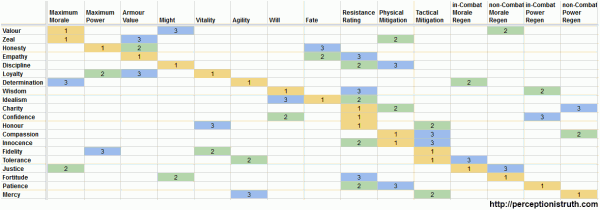 A lot has already been written on the web about Mass Effect 3. If you’re a gamer or you follow any gamers on social media sites, you must already have heard about ‘the ending’ and why a lot of fans are unhappy, and the gradual increase in ‘stop crying’ posts in response. I just wanted to put my thoughts down after having played all three games. Be warned: there will be huge stonking spoilers ahead, you can’t avoid commenting in depth on the game without spoilers. In fact, spoilers below for all three Mass Effect games basically.
A lot has already been written on the web about Mass Effect 3. If you’re a gamer or you follow any gamers on social media sites, you must already have heard about ‘the ending’ and why a lot of fans are unhappy, and the gradual increase in ‘stop crying’ posts in response. I just wanted to put my thoughts down after having played all three games. Be warned: there will be huge stonking spoilers ahead, you can’t avoid commenting in depth on the game without spoilers. In fact, spoilers below for all three Mass Effect games basically.
Category Archives: Games
Why Skyrim could be Awesome
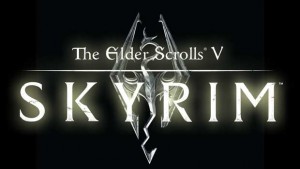 It’s easy to bash Skyrim, it’s such a huge vast target that you can’t really miss. I don’t want to bash it. I certainly do want to acknowledge the insane amount of work that clearly went into it and the games before it, the lore building, the world building, the quest complexity, it’s all there in front of you. The team who put it together clearly love it, and it has millions of fans around the world. Many hail it as the pinnacle of computer based roleplaying, almost equivalent to tabletop, albeit it a solo effort rather than group based.
It’s easy to bash Skyrim, it’s such a huge vast target that you can’t really miss. I don’t want to bash it. I certainly do want to acknowledge the insane amount of work that clearly went into it and the games before it, the lore building, the world building, the quest complexity, it’s all there in front of you. The team who put it together clearly love it, and it has millions of fans around the world. Many hail it as the pinnacle of computer based roleplaying, almost equivalent to tabletop, albeit it a solo effort rather than group based.
For me though, while Skyrim certainly reaches for the sky, it doesn’t quite manage to grasp the prize. So this isn’t a dig at Skyrim, it’s a bunch of things I think could have been done that would have resulted in hitting that elusive target.
Less defaulting to amoral activity
Skyrim is all about choice, some people say. It’s a sandbox world in which you can do anything you like, experience the game any way you wish. But that’s frustratingly not true. Too many quests have only a single outcome, too many quests involve only one route to completion. Many of the quests force an amoral attitude, if you want to complete it then you have to basically be a certain kind of character.
You are asked at one point to shut down a Skooma smuggling operation. Excellent, here’s a chance, I thought, for me to employ my superior speech skill to convince the smugglers they need to move out before Something Bad Happens. Alas no, the moment you get within 50 feet of the cave entrance, you get attacked, and the next 20 minutes is spent slaughtering everyone in the cave, including a barkeep.
If there was choice, then you would be able to talk your way in, convince them to shut up shop (or convince them to give you their proceeds so you can lie and say you shut them down) and move out. Sure, you should be able to slaughter them if you want, but it shouldn’t be the only resolution.
I already blogged about one quest where I wanted to help out the Jarl and his son and ended up with almost no choice but to steal an evil sword.
When I first went to Riften, I ended up in the ‘join the Thieves guild’ quest line almost by accident (more on that problem later). Despite not having a personal investment in the world (see below), I had been trying to play an honourable and noble warrior, staying out of trouble and not stealing anything. I met a character in Riften who seemed to be poised to try and take out the Thieves guild. That sounded like a good idea, so I went looking, but the only thing I could find was how to join. I did a little bit of reading on the web and sure enough, you can join, and the only eventual outcome of that chain of quests is to restore the Thieves guild to its former glory.
No choice to destroy it, and you miss out on a massive set of quests if you don’t join and take part. Fine, if you really don’t want to play a rogue you don’t do the quests, or maybe you start a new character another time and play everything sneaky and evil. But you’re forced to either be a burglar and thug or not do the quest line at all. Where’s the choice there? Where is the depth and the involvement in the world? I’d rather have a few less kill the bandit quests and instead get two or three quest lines in Riften where you can either join the guild, work to destroy it, or work to destroy it only to find out it serves some higher purpose and then have to change sides half way through.
That’s choice, that allows me to define my character by my choices, not by the quests I end up falling into.
So, yes, there are ‘good’, ‘neutral’ and ‘bad’ quests, but there are few, if any, quests which offer multiple outcomes depending on how you play them out. As a counterpoint, there is absolutely one quest which did this, and I was so pleased. In a temple you work with a priest to destroy an evil artefact, right at the last moment you are tempted by it and offered the choice of killing the priest or continuing with the destruction. It’s a tiny moment of choice, but it allowed me to define my character in the world. More of that, less of the Whispering Door rubbish.
More personalised investment
The epic nature of the game is certainly impressive; civil war, end of the world, return of dragons, etc. But in Skyrim you are left to find your own personal motivation and personal investment. That’s certainly one way of doing things. Perhaps experienced roleplayers can invent their own personal story, but I can’t help feeling that the game would have been more epic, more involving if the was some personal back-story for your character early on.
Of course, you can invent your own. You start out in chains after all, so you get to choose why you were arrested; falsely accused, petty thief, involved in a sinister assassination attempt, the choices are endless. However, because they’re endless, you have to be a very specific kind of player to keep one in mind. I’m not suggesting the development team should have come up with 8 specific back story options and forced you to choose one (although it works well in my view in Dragon Age), but you start the game adrift in a sea of choice, and without anything to ground you, the first few quests seem impersonal.
I would have liked to see either some early conversations where you can work out your own back story, or a more specific personal involvement in the ongoing story. You become the Dragonborn, and you develop a place and reputation in the world from your actions, but I didn’t feel part of the world because I didn’t feel connected to it from the outset.
Fewer instances of ‘what are you talking about’?
I get it, really. The world is vast! There are hundreds of intersecting quests, thousands of NPC’s, millions of lines of dialog, and probably more ways to journey through the game than there are neural connections in the brain or something. So it shouldn’t come as a surprise that every now and again you get a piece of dialog that makes no sense.
But it’s not every now and again, it’s reasonably common once you step out of the first major location. Travel somewhere new, and talk to a random stranger, and end up in a dialog about how sad it is that a third girl is dead. Huh, I thought, which girl? Later you stumble onto the crime scene and everything becomes clear. This could be handled much more elegantly, with the first person saying “Oh, haven’t you heard about the deaths then …” but no, they just assume you know, and your character just goes along as if you do, all the while in your head your screaming “who are you and what are you talking about”.
Again, if it was a one-off, like the amoral quests, it wouldn’t be so bad, but it’s common. You get the back end of a conversation because you didn’t walk into the city using the right route, or you moved slightly quicker than the developers thought anyone might or you didn’t quite complete a conversation they thought you would.
Like I say, I get it, it must be almost impossible to QA this kind of stuff, on this kind of scale, in a sandbox environment. I’d just like it to be more polished. It’s not just Skyrim that suffers from this, there’s elements of it in Fallout and Dragon Age as well, but I can’t remember a single instance of it ever in Mass Effect. Clearly the scope of Skyrim and the open nature of the world is far greater than Mass Effect, but I just wish there could be mechanisms in place to reduce the chance of it happening.
Wait, what quest?
I like the feature that over hearing people speak gives you a quest, it’s nice. I like the bounty quests, I like the barkeep rumour quests, and I like how most of the quests in the game are handed out. But there are times when you think, wait, how did I get into this, I don’t want do to this, and there’s nothing you can do. You can’t remove the quest, so you either ignore it, or you complete it.
In Riften, I spoke to a guy in the market place, and before you knew it, I was stuck with the first step in joining the Thieves guild. Sure, I could have not bothered, but I got into the conversation to find out more, to see if there was something I could do to stop the guild. However, the only dialog options that seemed to present an opportunity led to me suddenly being in a position where I was expected to set some guy up for a crime he didn’t do.
This isn’t (as usual) the only example of this kind of thing. You end up hunting people down, trying to get their debts cleared, and a whole bunch of other things by simply having a conversation. Because you know these quests will likely only have one route to completion (see above), you sometimes don’t want to go further, but there’s no way for most of the quests to back out once you’ve started. Also, because the vast majority of the game is amoral you feel if you want to actually see any of the quests, you’re going to have to suck it up and play the bad guy every now and then, even if you started out trying to be noble.
I’d like to see a way to get out of quest, or a more obvious moment in the conversation where you might find yourself tied into actions you don’t want to be associated with. I don’t want hand holding, I don’t want huge signs telegraphing the intent of my quest giver, I like murky quests where you’re not sure if you’re doing the right thing, but if you’re doing that, you need a way to stop, change your mind and back out with actual quest results.
Romance? Forget romance!
You can get married in Skryim. If it’s not the most pathetic example of in-game marriage in existence I’m not sure what is. To get married, you wear a special necklace, tell someone you like them, and then get married. Subsequently you can take money from them every day and use them as a vendor in your house. That’s it. No interesting dialog options, no relationship, no significant impact. You earn more money and you can sell things from the comfort of your own home.
In fact, being married felt pretty much like buying the alchemy table furnishing for your house – you should just be able to buy a spouse from the Jarl like you do a kitchen table.
If marriage was added at the last minute as a cynical attempt to gain interest with a certain group of gamers, then it’s both shocking and tactless. If it was developed from the outset as a specifically included element of the game, then it’s badly thought out and badly implemented as well as shocking and tactless.
At least let me build a relationship, or learn something about the person in question, not just recover a single mammoth tusk (from another vendor) and then show her my shiny new necklace.
If any single thing in the game is a clear demonstration of why it has no soul, then marriage in Skyrim is surely it.
More soul
This is covered to some extent in the amoral section above, but I wish Skyrim had more soul. I wish your actions had more permanent impact. If you kill everyone in a house, even if you get away without being recognised, surely there should be talk about it in the tavern to make you feel guilty or glow with evil pride? When you set out on a quest for noble reasons, you should feel as though the people are truly impacted, not just that they now like you enough to let you take things from their shop without it being classed as stealing. It’s not an easy quality to get, and it is probably earned through an increase in the above elements, but without soul, Skyrim is just roleplaying by numbers.
Conclusion
Is it epic? Can I be anything I want? Do I control my own destiny? The answer to these questions is yes, as long as you don’t mind being a soulless amoral killer with no ties to the world and a trophy spouse.
Am I still playing? Is it enjoyable? Yes, I am still playing, because if you just accept the lack of choice, if you just accept that you’re going to be basically an amoral killer, then the mechanics can be fun, and the game can present some challenge. But, it could have been so much more. So. Much. More.
Skyrim has no soul
After saying I wouldn’t buy it, I ended up picking up Skyrim when clearing out the credit on our Gamestation card (on the assumption that soon, Game/Gamestation might not be around to honour that credit).
I played Oblivion, and it’s big and sprawling and lacking in focus, and I knew Skyrim was going to be the same, but what the hell; it’s huge, and let’s you play ‘whoever you want to be’ right? Well actually, no, not quite.
I totally agree with the content of this review, specifically this bit,
I finally realized the problem I was having with Skyrim: It felt soulless. I may as well have killed Agnis and taken her stuff, because what did it matter whether she was there or not?
But I think there’s more going on that just lacking in soul, I think Skyrim only offers the illusion of choice, through some badly designed quests. One of things you get to choose when roleplaying is if you’re a good guy, or a bad guy, or somewhere in between. At each stage you decide if you’re going to do the right thing, or the wrong thing, or that you’re not going to get involved. But with Skyrim, sometimes there’s only one outcome. Sure, you can ‘walk away’, but that’s not easy to do when you can’t remove quests without completing them, and when it’s not always clear what the outcome will be.
Here’s a specific example, with spoilers for Skyrim so stop now if you don’t want to read it.
Computer games – do you always play the ‘same’ archetype?
Many types of computer game have you taking on the role of the main protagonist. Sometimes you get almost no choice about the kind of person you’re playing and sometimes you get lots of choice. However, even with games such as Modern Warfare you often get a choice of weapons that can dictate your play style. At the other end of the spectrum are games like Skyrim where you have almost unlimited choice in how you play your character.
I find that no matter which game I’m playing, I tend to gravitate towards a small subset of archetypes for my initial play through. I may replay the game later with a different class or approach, but usually I stick to my tried and trusted standards.
I can split the archetype choices down into two basic categories. If the game is primarily fantasy based (Dragon Age, Skyrim, Dungeon Siege III for example) then I will most often play a warrior with sword and shield. I tend to relegate stealth, ranged weapons and magic to the back burner in fantasy games. Sure I’ll shoot an arrow if necessary, and I can sneak if the quest demands it, but I’d rather be standing tall in the middle of the battle, crushing the enemy with my shield and beheading them with my shiny sword.
If the game is modern, sci-fi (Borderlands, Mass Effect) or post-apocalyptic (Fallout, Fallout New Vegas) then it tends to include projectile weapons (i.e. guns). In those games, I usually always play a soldier style role with medium range high accuracy weapons by preference (assault rifles and other rifles, machine guns at a push). I love sniper rifles in those games, or anything which lets me shoot from very long distances. Again, I tend to avoid specifically stealthy options, close combat weapons (shotgun, pistol), melee weapons, low accuracy rifles (sub-machine guns) and the like. If the game has powers (like Mass Effect or Borderlands) I tend not to use those either unless they’re integral to the game.
On a second or third play through I might go for rogues/thieves or magic/powers based characters, and if the game supports lots of facets I’ll often pick up rogue-like skills as secondary support skills.
But generally, you’ll find me knee deep in dead goblins waving a sword and hiding behind my shield, or ducked behind cover 300 yards from the enemy looking down the scope of an assault rifle or sniper rifle waiting for the just, the, right, moment.
I find it amusing sometimes that in fantasy games I opt for the in-close with a melee weapon option and eschew bows and long range magic, and yet in modern and futuristic games I hate melee weapons with a passion. I’ll use the chainsaw once, for fun, but I’ll always go back to my trusty assault rifle.
Beating Vector TD – easy and normal
I’ve been playing Vector TD on and off for ages. Up until this morning, it’s always been a pretty significant challenge. Although I’ve been able to beat the easy maps it’s never consistent, and even the normal maps have been tough for me, often ending with me losing around wave 44+.
I’m sure many people reading this are thinking ‘you dick, it’s easy’, but at least two folk on Twitter commented they don’t find it that easy and one person asked me to describe my new found strategy, that this morning allowed me to beat both easy levels and two normal levels without losing a single life, and the third normal level losing only one life. So, this post is for them.
There’s not much to the strategy, and this isn’t a step-by-step guide (although the first few steps are common), it’s a number of basic rules that I followed this morning.
Basic rules
- Unless you have absolutely no choice, do not upgrade any towers, or buy any towers in between waves. Always upgrade/buy towers after starting the wave, this gives you the best interest earned on your cash.
- Always take increased interest from the bonus waves. By wave 44 you should be getting 27% interest on your cash. You can use the wave 45 bonus to buy a damage or range increaser if that suits, because by then, cash won’t be an issue.
- Place as few towers as necessary, don’t place them pre-emptively if you can at all help it.
- The aim is to maximise cash, so that after each wave, you end up with either more cash than you started the wave with, or at least nearly the same amount. This means you get constant ‘free’ upgrades and towers.
- You can beat all 5 levels with four tower types. One maxed Green Laser 1, one maxed Red Refractor, one maxed Blue Rays 1, a whole bunch of level 1 Blue Rays 1 and as many high level Red Rockets as you can afford.
- Only the Fast Yellow creeps should be an issue at any stage.
Specific approach
- Your first tower should be a Red Refractor. This uses $200 of your starting $275. On it’s own, and placed correctly, this single tower can defeat the first 3 waves without any upgrades.
- You should place the tower in a position on each map so that it gets two goes at all the creeps on each wave. I pick specific spots, and you might prefer other ones, but the key is to ensure the creeps have to move quite a way to get back in range, to give the tower time to focus on both lines of creeps. You can see below where I place my starting 3 towers on each map.
- Do nothing for the first three waves. Let that one tower defeat them all, don’t upgrade, don’t spend any money. If that single tower doesn’t work, you need to find another spot on the map.
- The fourth wave is a green wave. The red tower will struggle, but at this point, you’ve got quite a bit of cash saved up. I place a green tower (boring names, compared to red), next to the red tower, and maybe boost it to level 2. This should easily defeat wave 4.
- I then place a blue tower right next to the red and green ones we’ve got so far for waves 5 onward.
- Over the next few waves, during the waves only, upgrade those towers only if your creeps almost get past them on the second pass. By that I mean, your towers should destroy more than half the creeps as they go by the first time, as they round the corner and come back, your three towers should easily wipe them out. If it was close, or you don’t clear half as they go by first time, upgrade the towers a little bit. Preserving cash should be your main focus.
- I tend to get the green tower to level 10 quickly because it’s cheap, and because the Red Refractor struggles on the green waves.
- You should easily and quickly get to $3000 or $4000 in the bank, with just those three towers by the time they are all level 10. You might need an emergency tower for the swift yellow creeps further along, don’t invest too heavily and don’t worry about placing lots of cheap towers anywhere at this stage.
- The entire rest of the game is now about adding Red Rockets and Blue Rays, without spending too much money. I usually buy the first Red Rocket when I have around $6k in the bank.
- Each Red Rocket should be configured to target weak creeps first and to have target locking disabled. This ensures you get rid of as many creeps in each wave as possible. If you end up with one strong creep surviving, so be it, but it’s frustrating to watch them spend ages trying to kill one strong creep while 15 weak ones get through.
- Each Red Rocket should be placed to give good coverage, don’t put them all in one place, but do try and ensure they all overlap as well. Don’t put them anywhere that will mean more than 40% of their coverage is walls.
- You should place Blue Rays all around the entire track, one every 3 or 4 squares. You don’t need to increase them beyond level 1 at all. When you have $15000 in the bank at the end of every wave, and you’re earning 20% interest, you can add 10 level 1 Blue Rays without decreasing your bank balance, so you can quickly swamp the map and turn the whole thing into treacle.
- Spend each wave slowly adding Red Rockets, levelling them all together up to around level 6 or 7 and adding Blue Rays. Do this while keeping your bank balance always over $10k if possible.
- Once you defeat wave 45, you can blow the rest of the cash on increasing the Red Rockets to level 10 and sit back and wait for victory.
- I usually end up with between 7 and 8 Red Rocket towers, each between level 7 and 10 by the last few waves.
Maps
These are where I place my 3 tower startup for each map. Only the second easy map doesn’t have any single good spot, and it can get a bit ‘exciting’ on the 3rd wave and the first yellow wave.
Good luck, I hope it helps.
I can’t yet beat any of the three hard maps, mainly because the choke points don’t work well enough and you need to have more than three towers on the go very quickly.
Gears of War 3
 Finished Gears of War 3 yesterday after a long hiatus (in which I basically finished Dead Space 2, Mass Effect 1, Mass Effect 2 again, and some other stuff). Playing GoW3 after finishing ME1/ME2 reminds me of the major difference between third person shooters and third person shooters with roleplaying elements.
Finished Gears of War 3 yesterday after a long hiatus (in which I basically finished Dead Space 2, Mass Effect 1, Mass Effect 2 again, and some other stuff). Playing GoW3 after finishing ME1/ME2 reminds me of the major difference between third person shooters and third person shooters with roleplaying elements.
GoW3 is relentless. Kill your way through a bunch of the enemy, moving from cover to cover with the odd moment of heroic full on battle charging thrown in, watch a 2 minute cut scene, and then rinse and repeat. During the scenes you are an observer, not a participant, watching a scene take place from some eye-in-the-sky camera.
This isn’t a complaint by the way – just an observation (an obvious observation). I had to take a 5 or 10 minute break after most of the long set pieces in GoW3 just to break that relentless feeling of bullet-powered progression. It’s probably the exact feeling the game designers were going for.
With games like Mass Effect, there are long stretches of combat (more so in ME2), which can feel pretty relentless, but thrown in you get periods of dialog in which you control the direction, and I think that’s the key about why I prefer those games over just standard 3rd person shooters. You are more invested in the character, you do feel more part of the story rather than an observer of it.
Anyway, Gears of War 3 was fun, I took too long a break to really say if it was gripping and I can’t say much other than it was pretty much like the first two. Fun, frivolous and entertaining, but on a different engagement level than Mass Effect, Dragon Age, Fallout, etc.
Mass Effect
 Mass Effect 1 and 2 are old hat, been out ages, surely no one in their right mind would start talking about them now when Mass Effect 3 is just around the corner? Well, I’m not in my right mind.
Mass Effect 1 and 2 are old hat, been out ages, surely no one in their right mind would start talking about them now when Mass Effect 3 is just around the corner? Well, I’m not in my right mind.
Grete played (plays?) ME1 and ME2 to death on the PC, she loves them and the Dragon Age games. I had ME2 on the Xbox 360, played it one and a half times, and then sold it on to fund more games. I promised myself that’s what I’d do with nearly every game I bought, new or second hand. I didn’t want to end up with a huge pile of games, played or unplayed. Anyway I never bought or played ME1. With ME3 around the corner, Grete wanted to see ME1 and ME2 ‘on the big screen, with surround sound’, so she picked them up super cheap for the Xbox from the local store.
I picked up the DLC’s for them both (the ones I didn’t already have for ME2) and thought I’d give ME1 a shot. It’s pretty good! It’s odd playing ME2 before ME1 for a couple of reasons. First, you kind of know where the story is going, but the flip-side is you go through a lot of ‘aahhhhhh riiiggghhhttt’ moments when you discover stuff that leads to things you did in the second game. Secondly, the mechanics change a lot between games, and having to handle a million equipment upgrades in ME1 was not fun, especially knowing ME2 gets rid of that mechanic almost entirely.
But what really sets ME1 and ME2 apart from the general gaming population is the story and the characters. I love it and them, and ME1 proved no less enjoyable than ME2. In fact, I got 60 hours of game-play out of ME1, and another 45 hours out of ME2 even though it was my second play through. ME2 straight after ME1 was a much better experience than previously, and being able to bring the ME1 character along made some of the decisions more personal.
I love the setting, the Space Opera style and the world building. The little details and the massive scale work really well together. I’ve spent the last two weeks feeling like I want to write a huge epic space opera story myself, although to be honest, what I most want to do is all the world building that goes into it. Never could find a story inside myself I wanted to tell enough to actually write anything.
Mass Effect 3 demo looks good – very interesting approach offering three play styles. Story mode – reduced combat involvement, full dialog options; Roleplaying which is the same model as the previous games; Action which reduces conversations down to cut scenes (I’m guessing you can still pick Paragon or Renegade using the triggers) but provides the full combat experience. If more companies can pick up that approach, offering just as much content but with a range of roleplaying levels it would be excellent. I’d love to play Modern Warfare with a significantly improved roleplaying feel.
Not sure how the multi-player will work out – and I hope the ME3 mechanics (which look to be somewhere between 1 and 2) don’t overwhelm the play. I’m sure we’ll find out.
Either way – the Reapers had better watch out, I intend to convince the entire Galaxy to make a stand, and Hold The Line.
Lord of the Rings Online – Virtues Summary
So, as well as the online spreadsheet / document (which is here), I’ve included a summary image below, which shows the twenty LOTRO Virtues, and which character stats they now provide.
1 / gold indicates the Virtue’s primary stat.
2 / green indicates the secondary stat and,
3 / blue indicates the tertiary or least valuable stat.
Click the image for the full version.
Lord of the Rings Online – Virtues – Post-Isengard
With the release of Rise of Isengard, Turbine have changed the character attributes within Lord of the Rings Online. For example, they have consolidated all the different resists such as poison, disease, wounds etc. into a single Resist Rating.
As a result, the Virtues have had to completely change to map against the new statistics. I have put together a Google Docs Spreadsheet showing the new Virtue values since the release of Rise of Isengard.
You can view the spreadsheet here.
Leave a comment against this post if I’ve made any mistakes or if you can fill in any of the gaps.
Lord of the Rings Online – The Rise of Isengard
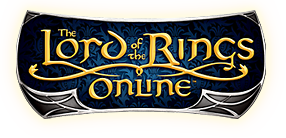 The Rise of Isengard is a full expansion for Lord of the Rings Online. It’s not free content, you have to pay for it, and it brings new levels (10 to be precise). That’s the same number of new levels that we got with Moria. Along with the levels, ROI brings three new areas, hundreds of quests, some new skills but more importantly, a complete revamp of character attributes and itemisation.
The Rise of Isengard is a full expansion for Lord of the Rings Online. It’s not free content, you have to pay for it, and it brings new levels (10 to be precise). That’s the same number of new levels that we got with Moria. Along with the levels, ROI brings three new areas, hundreds of quests, some new skills but more importantly, a complete revamp of character attributes and itemisation.
In the weeks and months up to the release of Isengard, classes underwent several changes, mostly to tweak unused skills or providing missing functionality. Isengard has built on that for most classes and in some cases, such as the Minstrel, has fundamentally changed their skill line-up. The overall intent appears to be to make the classes more balanced, and provide all players with a role in groups. I won’t cover the changes to all the classes here, there’s too much to go through, instead I’ll just describe my experience with Isengard and my overall enjoyment. The article got a bit long – sorry about that.
Getting There
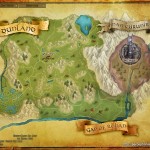 It’s traditional in LOTRO to move you between one area and the next using the Epic quest line. You don’t have to do it that way usually (Moria was an exception) but it’s clearly the intended or preferred method. Rise of Isengard is no different, you receive a letter, asking you to report to one of the Rangers in Enedwaith, eventually leading you into Dunland, which is the entry point to the Isengard expansion. A nice little unique element is that the Epic provides two routes via two different quest lines. Following one doesn’t exclude the other, since you can go back and retrace your steps, but it’s clearly designed to offer choice and prevent massive overcrowding. Dunland itself is south of Enedwaith, and the quests take you either directly south, or south-west and into the new land.
It’s traditional in LOTRO to move you between one area and the next using the Epic quest line. You don’t have to do it that way usually (Moria was an exception) but it’s clearly the intended or preferred method. Rise of Isengard is no different, you receive a letter, asking you to report to one of the Rangers in Enedwaith, eventually leading you into Dunland, which is the entry point to the Isengard expansion. A nice little unique element is that the Epic provides two routes via two different quest lines. Following one doesn’t exclude the other, since you can go back and retrace your steps, but it’s clearly designed to offer choice and prevent massive overcrowding. Dunland itself is south of Enedwaith, and the quests take you either directly south, or south-west and into the new land.
ROI is not as big as Moria. Let’s face it, Moria was just huge. It achieved that size through a combination of vertical movement, forced routes (making you track back and forward in a location to generate more distance within the same volume) and lots of distinct locations with their own look and feel. ROI doesn’t have that luxury, there are only 3 different major locations (described below), but the developers have tried hard to make them feel distinct.
Dunland
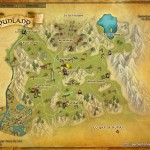 Dunland is a vast open area that you reach south of Enedwaith. It is populated very much like Enedwaith. There are a series of encampments with native men, who may be allies or enemies, spread throughout a mixture of terrains. Dunland is probably larger than Enedwaith overall, but not by a huge amount. The level of creatures and enemies increases from 65 to the high-70’s as you progress across the landscape. In order to make the area feel larger than it is, Turbine have employed the ‘having to run around large pieces of scenery like mountains’ so you need to cover more ground to get from A to B than it would take as the eagle flies. I understand the intent, but it can be frustrating to be standing right next to a quest ring or NPC only to find out you’re another 5 minutes away and have to circle back. Once again, almost every camp has a stable master, and Galtrev in the centre acts as the major hub for this region.
Dunland is a vast open area that you reach south of Enedwaith. It is populated very much like Enedwaith. There are a series of encampments with native men, who may be allies or enemies, spread throughout a mixture of terrains. Dunland is probably larger than Enedwaith overall, but not by a huge amount. The level of creatures and enemies increases from 65 to the high-70’s as you progress across the landscape. In order to make the area feel larger than it is, Turbine have employed the ‘having to run around large pieces of scenery like mountains’ so you need to cover more ground to get from A to B than it would take as the eagle flies. I understand the intent, but it can be frustrating to be standing right next to a quest ring or NPC only to find out you’re another 5 minutes away and have to circle back. Once again, almost every camp has a stable master, and Galtrev in the centre acts as the major hub for this region.
Gap of Rohan
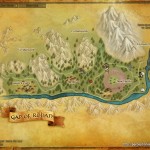 The Gap of Rohan looks very much like Dunland, but is significantly smaller. There are two or three major quest hubs with smaller quest NPC’s scattered throughout. The Gap is a really narrow strip of land, and is where you finally begin to engage full time with the Riders of Rohan.
The Gap of Rohan looks very much like Dunland, but is significantly smaller. There are two or three major quest hubs with smaller quest NPC’s scattered throughout. The Gap is a really narrow strip of land, and is where you finally begin to engage full time with the Riders of Rohan.
Isengard (Nan Curunir)
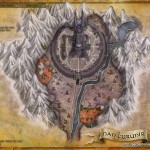 Isengard is split into three locations. The outskirts (Nan Curunir), the area just outside the tower, and the tower itself (accessed through various instances). For me, this is the most interesting set of locations in the game, although the outer terrain is also the most frustrating. There’s nothing worse in my view, than scenery you can see over, but can’t jump over or easily move through (in this cases, fallen trees that you can’t jump). As a consequence, moving around here can be very frustrating, but it’s worth it. It gives an excellent feeling of the bleak and terrible impact Saruman is having on the landscape and contrasts really well against the bright heather-strewn landscape of Dunland.
Isengard is split into three locations. The outskirts (Nan Curunir), the area just outside the tower, and the tower itself (accessed through various instances). For me, this is the most interesting set of locations in the game, although the outer terrain is also the most frustrating. There’s nothing worse in my view, than scenery you can see over, but can’t jump over or easily move through (in this cases, fallen trees that you can’t jump). As a consequence, moving around here can be very frustrating, but it’s worth it. It gives an excellent feeling of the bleak and terrible impact Saruman is having on the landscape and contrasts really well against the bright heather-strewn landscape of Dunland.
The Story
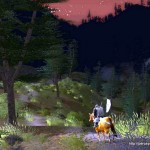 Rise of Isengard continues and apparently will conclude your journey with the Dunedain that started all those books and epic quests ago. Like Enedwaith, this story basically describes how you help the Rangers travel through hostile land, win over the trust of the native tribes (or not, as the case may be) and how you learn of Saruman’s treachery. There’s not much to say on it to be honest, it feels like a footnote in the epic quest so far, and not that epic, but it’s inoffensive and if you love the Rangers you’ll enjoy interacting with them again. It does have some tongue-in-cheek moments I think, for example, you get to watch the Rangers collecting wood, running errands and gathering apples just like they’ve made you do for the last hundred epic quests.
Rise of Isengard continues and apparently will conclude your journey with the Dunedain that started all those books and epic quests ago. Like Enedwaith, this story basically describes how you help the Rangers travel through hostile land, win over the trust of the native tribes (or not, as the case may be) and how you learn of Saruman’s treachery. There’s not much to say on it to be honest, it feels like a footnote in the epic quest so far, and not that epic, but it’s inoffensive and if you love the Rangers you’ll enjoy interacting with them again. It does have some tongue-in-cheek moments I think, for example, you get to watch the Rangers collecting wood, running errands and gathering apples just like they’ve made you do for the last hundred epic quests.
Outside of the epic specifically, Dunland is a land besieged and under the thrall of Saruman even if the natives don’t realise it. War is coming, none can avoid it, all must choose sides, and as usual you’re the catalyst in that process.
Reputation & Rewards
There are two reputations in Rise of Isengard. Men of Dunland and Theodred’s Riders. The early part of the expansion offers mostly Men of Dunland, with the later parts and the later epic providing Theodred’s. You’ll hit Kindred with Men of Dunland by just doing the quests, but you’ll need to work harder with the second reputation, repeating daily quests and doing as many tasks as you can find.
As is common now, both reputations have vendors, but this time the currency is regular money! No odd flowers, or strange branches or lumps of rock. The prices of some of the reputation items (and there are a lot) are quite interesting, some of them over 2gp. I like the new approach, the quests and mob drops give a good cash input, and you can earn cash anywhere else in the game you like and then come and buy reputation items.
The quest rewards are many and varied, and in part, drive the problem I have with itemisation (you’ll read that bit later). Many quests give a choice between three items, it may be 1 piece of jewellery, 1 piece of light armour and 1 cloak, or 1 piece of heavy armour, 1 piece of medium armour and 1 piece of jewellery. Because of the new itemisation, and the move away from 1 x light, 1 x medium, 1 x heavy or 3 pieces of jewellery, you have to pick your quest rewards carefully, plan ahead and hoard what you get in order to successfully use them as upgrades.
Questing
Questing in Rise of Isengard for the most part matches the experience in Enedwaith and Mirkwood. Quest hubs provide introduction quests, and then move you around the landscape. There’s a common theme in ROI, where a quest NPC will give you 3 quests, and then another 3 once those are complete. Many of the quests are standard fair, collecting items, killing the enemy, but there are signs that the Turbine team are trying to find new questing experiences. There’s a quest to return lost horses which was quite nice, and some of the instances have new mechanics (specifically where you lead teams of good guys against lots of bad guys). I’ll say no more so I don’t spoil some of the better instances.
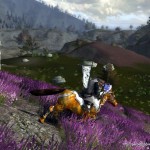 The vast majority of the quests are soloable at ‘even con’ (i.e. the same level as you), and the XP gains mean if you do all the quests you’ll level at the right speed. It’s a bit frustrating, I liked the old style quests where they were soloable with a challenge, much easier as a duo or trio, and the last stage tended to require a group. I know they’ve moved away from that format, but I really did prefer it. One very annoying feature in recent expansions is the exact opposite position, where the first few quests are out in the open, and then end in a solo instance. Some of those instances are uneven in difficulty and some classes might struggle, although after one or two goes you learn the best approach. ROI adds a new style of instance which ‘is designed to be solo but can be completed as a duo’. I’m really not sure what the intent was here, one of them configured like that doesn’t even involve any killing and it’s not consistent, some of the hardest are enforced solo, and others seem to randomly allow 2 people.
The vast majority of the quests are soloable at ‘even con’ (i.e. the same level as you), and the XP gains mean if you do all the quests you’ll level at the right speed. It’s a bit frustrating, I liked the old style quests where they were soloable with a challenge, much easier as a duo or trio, and the last stage tended to require a group. I know they’ve moved away from that format, but I really did prefer it. One very annoying feature in recent expansions is the exact opposite position, where the first few quests are out in the open, and then end in a solo instance. Some of those instances are uneven in difficulty and some classes might struggle, although after one or two goes you learn the best approach. ROI adds a new style of instance which ‘is designed to be solo but can be completed as a duo’. I’m really not sure what the intent was here, one of them configured like that doesn’t even involve any killing and it’s not consistent, some of the hardest are enforced solo, and others seem to randomly allow 2 people.
I would much prefer the Mirkwood approach where the final stage is actually a skirmish and so can be done with 1, 2, 3 or 6 people. My feeling is that Turbine ran out of time, and there are signs of rushed content all over the expansion.
Overall, the quests are like much of the rest of ROI – not hugely challenging and based on the concept of running around a lot.
The Enemy
Like killing Orcs? Like squishing Goblins? Enjoy defeating Trolls with 75k morale? You’ll love Isengard. It’s Orcs, Half-Orcs, Goblins, Trolls and Wargs. The staple diet of the Lord of the Rings enemy list. Those bad guys are interspersed with the usual wolves, some new lizard-like creature, massive turtles, undead, birds and native men. The enemy ranges from level 65 to 75 as you would expect, and I found them generally easier to kill than those in Moria. Some of them have a few tricks (watch out for the nasty fire DOT) but in general, there are few surprises.
The Good Guys
The good guys break down into three groups. Native people who you are working with to free from Saruman’s grasp, The Rangers you’ve been travelling with and the newly introduced Riders of Rohan. There’s the odd elf and dwarf thrown in for flavour, but that’s about it.
The Epic
Covered briefly in the story section above. The epic is okay, some of the quests are quite innovative, adding some functionality we’ve not seen before. There’s a definite sense of the team trying out new styles of quests and new ways to engage the characters. Overall though, it’s pretty boring in terms of actual content, once again we’re being point for the Rangers. I think Turbine recognise this, and they have announced we’ll be leaving the Rangers behind and instead, collecting bandages and digging up treasure troves for the Riders of Rohan going forward.
Crafting
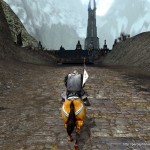 Isengard adds an entire new level to the crafting scheme, which I’m quite happy about. They’ve also taken the excellent decision to reduce the different kinds of raw craft resources for each craft, and then introduce new recipes to build intermediate ingredients. For example, rather than 3 or 4 types of metal (Khazad Iron, Khazad Tin, Khazad Gold, Khazad Copper) there is just one type – Skarn. That ore can be turned into low quality, medium quality or high quality ingots, using increasing amounts of the raw materials to do so (there’s also a shortcut, which I’ll leave you to discover). The end result is that resource collection is less complex and less frustrating (additionally improved by a huge increase in resource nodes), but recipes still have multiple layers and levels of complexity to work through. I love the new system frankly, and think it has greatly improved the crafting. I’d like to see them retrofit it for the previous levels but appreciate that would be a huge undertaking.
Isengard adds an entire new level to the crafting scheme, which I’m quite happy about. They’ve also taken the excellent decision to reduce the different kinds of raw craft resources for each craft, and then introduce new recipes to build intermediate ingredients. For example, rather than 3 or 4 types of metal (Khazad Iron, Khazad Tin, Khazad Gold, Khazad Copper) there is just one type – Skarn. That ore can be turned into low quality, medium quality or high quality ingots, using increasing amounts of the raw materials to do so (there’s also a shortcut, which I’ll leave you to discover). The end result is that resource collection is less complex and less frustrating (additionally improved by a huge increase in resource nodes), but recipes still have multiple layers and levels of complexity to work through. I love the new system frankly, and think it has greatly improved the crafting. I’d like to see them retrofit it for the previous levels but appreciate that would be a huge undertaking.
The new recipes are mostly interesting, although they suffer from my dislike of the new itemisation.
Along with the new craft level is a new craft guild reputation level and the associated tokens. That has definitely extended the time taken to move through Isengard because it gives you something else to focus on (some say time sink, others say interesting addition).
Some people are upset that you have to travel to Isengard to be able to complete recipes (I won’t give away why) which makes their tradeskill alts useless. Personally, I think if you’re going to learn how to craft in the style of The Westfold, it makes more sense that you have to travel there to learn it. My craft alts are all of an appropriate level anyway, so personally I think it’s a good thing.
New Levels & Skills
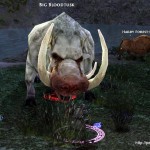 Ten more levels – not much to say except it’s nice to see the XP bar moving again after so long out of Mirkwood. Levelling is trivial, there’s almost no challenge in the game if you start the expansion at level 65, and it’s essentially a matter of just investing time to hit 75. I never died on my Guardian in the entire 10 levels, most of that was solo, and sometimes I found myself just fighting AFK while I made a drink.
Ten more levels – not much to say except it’s nice to see the XP bar moving again after so long out of Mirkwood. Levelling is trivial, there’s almost no challenge in the game if you start the expansion at level 65, and it’s essentially a matter of just investing time to hit 75. I never died on my Guardian in the entire 10 levels, most of that was solo, and sometimes I found myself just fighting AFK while I made a drink.
The new skills are a mix of nice and boring. Some classes get just upgrades, albeit with some interesting twists (for example, Guardians get no new skills, but their upgrades are interesting), while some classes get new skills which are a bit weak (Wardens get the ability to ‘store’ a gambit, but it’s not particularly exciting in the solo / group game). Isengard is lacking compared to previous expansions, Moria was far more progressive in terms of the new skills. Moria also felt tougher at the outset as well.
Character Stats
I won’t write a whole bunch on this – suffice to say Turbine have rationalised the character stats, and reduced the number of them down to a better level. It was getting crazy with 20 or 30 different statistics. I like the changes, I’m happy with the lumping together of some numbers.
Turbine have also added Finesse – a way to bypass your enemies defences. I’m not sure of the value of this for group / solo players, it still seems to be there primarily to make raid targets more challenging without a lot of gear upgrades (i.e. an enemy that has such high Block that you need 12,000 Finesse just to dent it). We’ll see if it survives longer than Radiance.
Legendary Items
Ten new levels of legendary items, and another revamp of the stats on relics thanks to the changes to the character stats. Nothing too exciting to cover, many people complained that for non-weapon LI’s there was no reason to upgrade away from their level 65 2nd age item. For weapons, you have to upgrade eventually just to get the DPS increase. Some of the artwork for the new items is quite nice, I prefer the one handed axes to the Mirkwood versions.
Itemisation
It will come as no surprise to my friends from in the game, that I think the itemisation changes in Rise of Isengard are a huge black spot on an other wise okay expansion. Turbine have taken the decision to polarise gear choice. Items now provide large bonuses to a small selection of character stats. For example, you may get +89 Vitality and +54 Might on a breastplate, but almost nothing else, or a neck item will have +50 Will, +50 Vitality and +50 Fate.
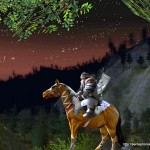 Read the developer diaries for the apparent reasoning behind this, the claim is that it makes gear choices more flexible. To me, it makes it significantly harder to manage your equipment choices. In the past, you could consider an item of equipment and compare it to your existing item and decide if it was an upgrade, a sidegrade or a downgrade. You could pretty much do that in isolation. Sure, sometimes you might want to augment a stat that you had lost elsewhere but gear tended to improve all your stats to some extent. Now when you see a chest piece with a huge armour increase, you can’t actually equip it without hugely impacting say your Power or Fate scores. Overall, a single piece might be a downgrade, and it’s only an upgrade if you also move around 3 or 4 other pieces of gear to compensate, or re-trait, or change your relics.
Read the developer diaries for the apparent reasoning behind this, the claim is that it makes gear choices more flexible. To me, it makes it significantly harder to manage your equipment choices. In the past, you could consider an item of equipment and compare it to your existing item and decide if it was an upgrade, a sidegrade or a downgrade. You could pretty much do that in isolation. Sure, sometimes you might want to augment a stat that you had lost elsewhere but gear tended to improve all your stats to some extent. Now when you see a chest piece with a huge armour increase, you can’t actually equip it without hugely impacting say your Power or Fate scores. Overall, a single piece might be a downgrade, and it’s only an upgrade if you also move around 3 or 4 other pieces of gear to compensate, or re-trait, or change your relics.
Gear management has become a spreadsheet and calculator affair, rather than something you can just eyeball and get a good feeling about.
You can’t slowly, incremental upgrade your gear. This is especially true switching from pre-Isengard gear to the new structure. Next time it might be different, but this time the change is painfully difficult. If you get a piece of gear as a quest reward, and equip it, you will end up being worse off in some regards, and you will need to compensate. If you are offered the choice between some Power heavy gear or some Morale heavy gear, you need to have a plan in mind otherwise you might choose Power gear only to be need to switch it out later when even more gear brings Power you don’t need. I refer to this as forcing Upgrade Cascades. You need to hoard rewards and gear and crafted items in case you need to radically re-arrange your gear to prevent the loss of some vital stats just to get a gain elsewhere.
What appears as a huge upgrade initially ends up being a trivial upgrade because you need to replace other gear to compensate.
Anyway, if I don’t stop it’ll end up being the whole article. My closing words, maybe I’m in the minority, maybe I think about this stuff too much, but I hate the new itemisation and the amount of work you will need to invest just to work out if a new piece of gear is an actual upgrade, and it has absolutely diminished my enjoyment of both RoI and LOTRO in general.
Is it any good?
So, here we are at last. Is it any good? I’ll damn it with faint praise, it’s okay. It’s nowhere near as iconic as Moria, it’s not as well put together as Mirkwood, it’s not as exciting as Moria either. It’s just okay, inoffensive, easy to progress through, offering very little challenge in-game. The greatest challenge is working out how to upgrade your gear. Some of the quests show a spark of originality, some succeed more than others, but many feel rushed and not quite finished.
Worst Bits?
Two things. Firstly, it’s too easy, there’s just no challenge. Secondly, there’s nothing to come back to later. There are 3- and 6-man instances in Moria and Mirkwood that I have still never finished and want to go back and complete. I’ve finished Isengard twice; everything except the raid. Even casual players will chew it up and then move on to another game.
Best Bits?
You get to kill a lot of Orcs.
I wanted much, much more from Rise of Isengard. Instead, I got an extension of Enedwaith; Forochel without the frost.






